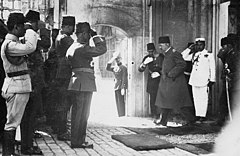Abolition of the Ottoman sultanate
 Departure of Mehmed VI, the last Ottoman sultan. | |
| Date | November 1, 1922 |
|---|---|
| Location | Ankara Constantinople |
| Participants | Mustafa Kemal Sultan Mehmed VI Turkish Grand National Assembly |
| Outcome | Exile of Mehmed VI; end of the Ottoman Empire |
On November 1, 1922, the Ottoman Sultanate was abolished by the Turkish Grand National Assembly and Sultan Mehmed VI departed the country. This allowed the Turkish national movement government in Ankara to become the sole governing entity in the nation, founding the Republic of Turkey the next year in 1923.
Background
Defeat in World War I
The Ottoman Empire, under Mehmed V and the Young Turks, had sided with the Central Powers during World War I. Despite initial successes against British Commonwealth troops, the tide turned against the declining empire and its allies, Germany and Austria-Hungary.
The Ottoman Empire lost much territory in both World War I and the preceding Balkan Wars,[1] completing its steady decline and dissolution, which had begun in the late 1600s. By 1918, when the Ottoman Empire left the war, it had lost much of its territory in its partitioning by the victorious Allied forces, with the exception of the Ottoman homeland of Anatolia.
Turkish War of Independence
Turkish national pride was greatly injured by the war, and many Turks grew weary of the centuries-old Ottoman political system. Especially infuriating was Mehmed VI's dissolution of Parliament, which resulted in the Turkish national movement, led by the general Mustafa Kemal, establishing another government in Ankara to oppose both the invading Allies and the old monarchist Constantinople government that championed the Sultanate.[2] Meanwhile, the Turkish War of Independence broke out between the nationalist army and Greek forces. Fighting was particularly severe in Smyrna, where a successful Turkish guerrilla campaign, led by Mustafa Kemal, prevented the Greeks from occupying the region (see Greco-Turkish War (1919–22)).
From 1920 until 1922, the Turkish nationalist government engaged in conflicts with neighboring nations and invading European powers, including France (see Franco-Turkish War), while the Allies secured Constantinople, Mehmed's capital.
The Grand National Assembly acts
Resolution proposed in the Assembly
On November 1, 1922, the nationalist Grand National Assembly declared that the Sultanate's Constantinople government was no longer the legal Turkish government, appointing the nationalist body in Ankara to that place. The Assembly also resolved that Constantinople had not been the capital of the nation since its occupation by the Allies.[3] The Constantinople government had shown some resistance against the Ankara government, forming the Kuva-yi Inzibatiye, known as the "Army of the Caliphate", to defeat the Turkish nationalist movement's Kuva-yi Milliye (National Forces), but was defeated by the nationalist forces. In yet another declaration, the Sultanate was divided into the office of the Sultan and the Caliph of Islam, positions which had been combined since 1517. The former position was abolished, and Mehmed's cousin Abdülmecid II was made caliph.
The Assembly was also prompted by an Allied invitation, given to both the Constantinople and Ankara governments, to appear at a conference at Lausanne. Mustafa Kemal was determined[4] that only the Ankara government would be represented at the conference.
Mehmed's departure
After hearing of the resolution, Mehmed VI sought refuge[5] aboard the British warship Malaya on November 17. After this, the remaining ministers in the Constantinople government eventually voluntarily accepted the Ankara government as the legitimate Turkish government, effectively ending the spat in the Ankara government's favor. Mehmed VI's cousin Abdulmecid continued on as Caliph until 1924, when that office was abolished as well.
References
- ^ Who's Who - Sultan Mehmed V. First World War.com (2009-08-22). Retrieved on 2013-08-12.
- ^ Turkish War of Independence. All About Turkey. Retrieved on 2013-08-12.
- ^ Turkish War of Independence. All About Turkey. Retrieved on 2013-08-12.
- ^ Turkish War of Independence. All About Turkey. Retrieved on 2013-08-12.
- ^ Who's Who - Sultan Mehmed VI. First World War.com (2009-08-22). Retrieved on 2013-08-12.
